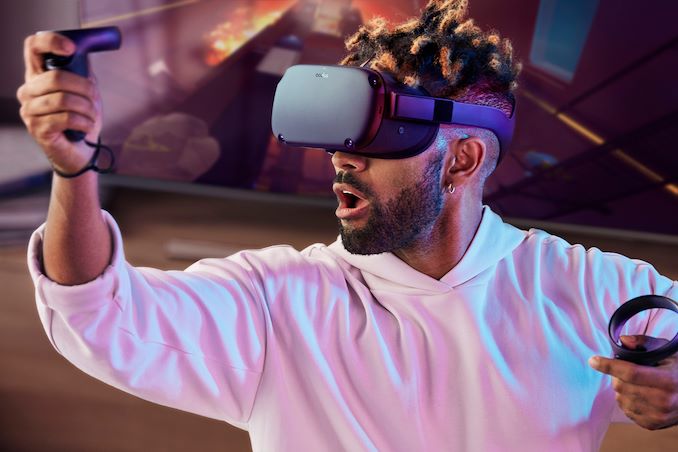Oculus Link Software Available: Oculus Quest Can Now Tether to PCs
by Anton Shilov on November 21, 2019 5:00 PM EST- Posted in
- VR
- Oculus
- Oculus Quest

Oculus VR this week started to distribute its Oculus Link software, enabling owners of the standalone Oculus Quest VR headsets to connect them to gaming PCs and play games originally developed with the Rift and Rift S in mind. For now, VR gamers will have to use a quality third-party USB 3.2 Gen 1 Type-C cable, but later on the company promises to release its own long cable.
From now, a beta version of the Oculus Link application for Oculus Quest is available from Oculus VR as a part of the Gear VR Build 11.0 software update. To connect the Oculus Quest to a PC, one needs a high-quality USB 3.2 Gen 1 Type-C cable, though since most USB 3.x cables are around 1.5 meters long, you'll want to track down a longer specialty cable. Otherwise, Oculus promises to release a five-meter long USB-C cable in the near future to provide more freedom. Meanwhile, PC users will want to pay particular note to the fact that only NVIDIA cards are supported with the Link software at this time; Oculus will be adding AMD support at a later date.
The Oculus Quest is a standalone VR HMD featuring a display of a 2880×1600 (1440×1600 per eye) and powered by the Qualcomm Snapdragon 835 application processor. The device comes with Touch controllers bundled with the original Rift, yet relies on its inside-out 6-degree-of-freedom (6DoF) positional and controller tracking that does not require any external sensors.
In theory, making Oculus Rift games available to owners of the Oculus Quest and a compliant PC is a big deal for Oculus VR as it expands total available market of VR PC games and therefore strengthens the entire platform. This clearly does not hurt in the light of the fact that the Half-Life: Alyx game is coming and many fans of the series will have to use a VR headset to enjoy it. Meanwhile, it remains to be seen how good the actual PC gaming experience offered by the Oculus Quest will be provided that it has a higher-resolution display (when compared to both Rift and Rift S) and uses a different tracking system.
Related Reading:
- Oculus Link Software: Connecting Oculus Quest to a Gaming PC
- Oculus Quest Announced: A 6DoF Standalone VR Headset
- Oculus Rift S VR Headset: An Upgraded Virtual Reality Experience
- VirtualLink USB-C Alt Mode Announced: Standardized Connector for VR Headsets
- Oculus Announces Oculus Go: Untethered VR For $199 USD
- Oculus Announces Six Week Sale of $399 Rift + Touch Bundle
Source: Oculus VR










22 Comments
View All Comments
edzieba - Friday, November 22, 2019 - link
Same number of pixels, just the wrong orientation (9:10 rather than the 10:9 one would expect from desktop monitors).Anton Shilov - Friday, November 22, 2019 - link
Thanks for pointing that out. Looks like some original PR materials contained the wrong resolution.Leonick - Friday, November 22, 2019 - link
"To connect the Oculus Quest to a PC, one needs a high-quality USB 3.2 Gen 1 Type-C cable"So a regular USB 3.0 cable then, USB 3.x naming sure isn't confusing at all is it?
Plenty of 3m 3.0 cables around with USB-C connector.
edzieba - Friday, November 22, 2019 - link
No, if it's Type C it's 3.1 Gen 1. 3.0 does not include Type C as part of the standard.Pretending "it's just 3.0, it's all the same!" is how you end up with issues with power delivery and port capability discovery.
Leonick - Friday, November 22, 2019 - link
3.1 Gen 1 is 3.0 renamed. Same goes for 3.2 Gen 1x1.With the introduction of 3.1 and 3.2 the added new top tier cables but Gen 1 in each is just 3.0 carried forward. All use the marketing name Superspeed USB, or are recommended to anyway.
Read through the USB 3.0 page on wikipedia if necessary.
rahvin - Monday, November 25, 2019 - link
For data throughput it's the same, but the type C port changes the power delivery and other stuff so it is actually 3.1 gen1, not 3.0.As the previous poster said, it's the same data rate but it's not the same spec, requiring 3.1 means they need the parts of the 3.1 spec that's aren't in the 3.0 spec, and that includes higher power availability and extra wires even if the data transfer speed is the same.
Death666Angel - Friday, November 22, 2019 - link
You know that you can get USB 2.0 in C fashion, right? Physical connector is not tied to the interface. Some weird Chinese company probably has SATA over USB C sometwhere. :Dhyno111 - Friday, November 22, 2019 - link
USB 3.2 Gen 1 is not an official name, so no idea if they mean USB 3.2 Gen1x1 or USB 3.2 Gen1x2,Although the Oculus support page simply recommends a 9$ USB 3.0 A to C cable, so I guess any long 5Gbps cable is fine.
farhadd - Friday, November 22, 2019 - link
Yeah, They could just call it a "USB 5Gb Type-C cable" or something akin to that. It's like UHD, WQHD etc- just call it 3840x2160, 2560x1440 etc and skip the confusing monikers. The letters don't add any value to the discussion.Leonick - Friday, November 22, 2019 - link
Superspeed USB is the recommended marketing term with the speed added for the 10 and 20Gbit/s cables, but that isn't exactly commonly used.